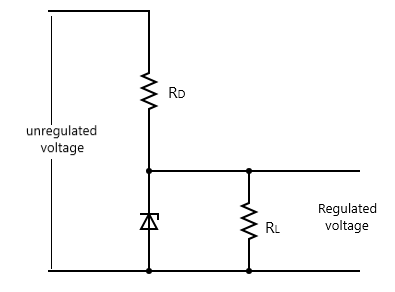
How is a zener diode fabricated? What causes the setting up of a high electric field even for small reverse bias voltage across the diode? Describe, with the help of a circuit diagram, the working of zener diodes as a voltage regulator.
Answer
543.3k+ views
Hint: The resistance of a zener diode changes with changing input voltage. Zener diodes are heavily doped on both semiconductors parts.
Formula used: In this solution we will be using the following formulae;
$ E = \dfrac{{dV}}{{dr}} $ where $ E $ is the electric field at a point, $ V $ is the potential difference, and $ r $ is the position or distance from a reference point (usually of zero potential).
$ \dfrac{{dV}}{{dr}} $ signifies the infinitesimal rate of change of the voltage or potential difference with distance.
Complete step by step answer:

For fabrication – the zener diode is made by heavily doping both the n type semiconductor and the p type semiconductor which makes up the diode.
What causes the setting up of a high electric field, even for small reverse voltage? Generally, we know that the electric field can be given as
$ E = \dfrac{{dV}}{{dr}} $ where $ V $ is the potential difference, and $ r $ is the position or distance from a reference point (usually of zero potential). $ \dfrac{{dV}}{{dr}} $ signifies the infinitesimal rate of change of the voltage or potential difference with distance. Or in its constant form $ E = \dfrac{V}{r} $
Hence, even for small voltages, if the distance is small enough as in the depletion layer of a diode, the electric field can be enormous.
The zener diode can be used as a voltage regulator as explained:
The zener diode is connected to a resistor $ {R_D} $ as shown in the figure, it is the combination that is then connected across the changing or fluctuating resistor. Usually, the desired constant voltage is gotten across a load resistance $ {R_L} $ .
When the input voltage is high, the resistance of the zener diode decreases. This causes the voltage drop across $ {R_D} $ is higher. This causes about the desired voltage to be left at the output. When the input voltage is low, the resistance of the diode increases, hence the voltage drop across the resistance $ {R_D} $ is low. Which still leaves about the desired voltage at the output.
Note:
For clarity, the voltage drop across the resistance $ {R_D} $ is higher at lower resistance because current is higher in such case and due to ohm's law the voltage is higher at a higher current if resistance (resistance $ {R_D} $ in this case)is constant .
Formula used: In this solution we will be using the following formulae;
$ E = \dfrac{{dV}}{{dr}} $ where $ E $ is the electric field at a point, $ V $ is the potential difference, and $ r $ is the position or distance from a reference point (usually of zero potential).
$ \dfrac{{dV}}{{dr}} $ signifies the infinitesimal rate of change of the voltage or potential difference with distance.
Complete step by step answer:

For fabrication – the zener diode is made by heavily doping both the n type semiconductor and the p type semiconductor which makes up the diode.
What causes the setting up of a high electric field, even for small reverse voltage? Generally, we know that the electric field can be given as
$ E = \dfrac{{dV}}{{dr}} $ where $ V $ is the potential difference, and $ r $ is the position or distance from a reference point (usually of zero potential). $ \dfrac{{dV}}{{dr}} $ signifies the infinitesimal rate of change of the voltage or potential difference with distance. Or in its constant form $ E = \dfrac{V}{r} $
Hence, even for small voltages, if the distance is small enough as in the depletion layer of a diode, the electric field can be enormous.
The zener diode can be used as a voltage regulator as explained:
The zener diode is connected to a resistor $ {R_D} $ as shown in the figure, it is the combination that is then connected across the changing or fluctuating resistor. Usually, the desired constant voltage is gotten across a load resistance $ {R_L} $ .
When the input voltage is high, the resistance of the zener diode decreases. This causes the voltage drop across $ {R_D} $ is higher. This causes about the desired voltage to be left at the output. When the input voltage is low, the resistance of the diode increases, hence the voltage drop across the resistance $ {R_D} $ is low. Which still leaves about the desired voltage at the output.
Note:
For clarity, the voltage drop across the resistance $ {R_D} $ is higher at lower resistance because current is higher in such case and due to ohm's law the voltage is higher at a higher current if resistance (resistance $ {R_D} $ in this case)is constant .
Recently Updated Pages
Master Class 12 Social Science: Engaging Questions & Answers for Success

Master Class 12 Physics: Engaging Questions & Answers for Success

Master Class 12 Maths: Engaging Questions & Answers for Success

Master Class 12 Economics: Engaging Questions & Answers for Success

Master Class 12 Chemistry: Engaging Questions & Answers for Success

Master Class 12 Business Studies: Engaging Questions & Answers for Success

Trending doubts
What are the major means of transport Explain each class 12 social science CBSE

Which are the Top 10 Largest Countries of the World?

Draw a labelled sketch of the human eye class 12 physics CBSE

How much time does it take to bleed after eating p class 12 biology CBSE

Explain sex determination in humans with line diag class 12 biology CBSE

Explain sex determination in humans with the help of class 12 biology CBSE




